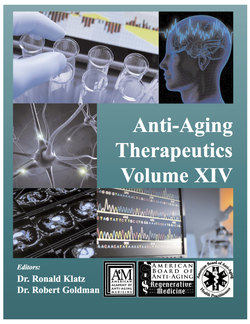Читать книгу Anti-Aging Therapeutics Volume XIV - A4M American Academy - Страница 73
На сайте Литреса книга снята с продажи.
INTRODUCTION
ОглавлениеToday, 86% of Americans ages 60 and older suffer from degenerative diseases. Aging increases the onset of disease with chromosomal distortions and exposure to toxic tissue stressors leading to diabetes, cancer, heart disease, arthritis, Parkinson’s, Alzheimer’s, fibromyalgia and a number of autoimmune condition’s at the cellular level.
In seniors a tragic and growing problem is memory loss, and brain dysfunction. Specific environmental and genetic factors increase the risk of hypertension, stroke, diabetes and childhood diseases including cerebral palsy and autism. The brain has over 100 billion neurons. Each neuron has 2,500 possible interconnections with each other. Nearly 60% of the brain consists of lipids and lecithin affecting structure, function and communication. A diet high in fats and low in antioxidants can lead to the formation of lipofuscin in the brain neurons. The brain consumes a disproportionate amount of oxygen. Hence, it becomes subject to free radical activity. Inflammation also contributes to the aging of many of the body’s organ systems, primarily the skin and brain. Oxygen consumption is mainly used by cellular mitochondria as a catalyst for energy production (ATP), which is an absolute necessity for physical strength, energy and maintenance of life. ATP production helps synthesize hormones including cortisol, adrenalin, dopamine, DNA repair enzymes, nucleic acid and other key substances.
Table 1 presents key assessments that may be useful to ascertain a patient’s biological age.
| Table 1. Assessment of Biological Aging |
| Lipids, total cholesterol, HDL, LDL, Non-HDL, ratio, free fatty acids, glucose |
| Microscopy under 40 x and 100 x. Objectives to phase contrast for live blood smears to observe morphology, shape of cells, and lipid material comparing fasting to postprandial –2 to 4 hours after a typical meal. It is important to perform a fasting and postprandial lipid testing (2 to 4 hours after eating) |
| Observation of dry blood smears under bright field microscope 4 x or 10 x. Detect Reactive Oxygen Toxic Species (ROTS masses) |
| Oxidative stress markers. Uurine lipid peroxides, 8-OHdG |
| Nitric oxide test saliva |
| Telomere testing |
| Toxic metals or element exposure hair, urine |
| Urine 24-hour metabolites of estrogen including 16aOHE and 2 OHE, Free T3, cortisol metabolites, androgen metabolites, Human Growth Hormone (HGH) |
| Blood Tests for binding proteins: transcortin for binding proteins of cortisol, SHBG-binding proteins of estrogen and testosterone, IGBP-3 binding protein for IGF-1, DHEA, thyroid for free T3, C-reactive protein, LH, FSH, Male PSA, female progesterone |
To slow aging we must repair and replace a significant number of cells subject to stressors of low oxygen and toxins. The anabolic repair process can be restored with hormone intervention to keep up with the catabolic process to preserve the organisms. Testosterone and growth hormone have proven to be effective anti-inflammatory agents in the efforts to restore organ and brain function. Sex hormones are highest in the longest lived people of Okinawa. Suzuki reported that centenarians (age 100+) in Asia had higher natural levels of testosterone, DHEA and estrogen than 70 year old men or woman in the USA. Dr. Weeks reviewed over 3,500 patient’s age 18 to 102 years. His research showed that those with the highest frequency of intimate contact lived the longest with fewer wrinkles, better posture, stood taller, and had a lighthearted attitude. Optimizing hormone levels to youthful levels of a 22 year old with herbs and bio-identical hormones may improve organ and tissue repair and combat aging.
Over time we must cleanse and refresh our cells and organs to allow proper replication of genetic information, reduce stress to the tissues, increase functional excretion of waste by-product, cellular waste and enhance enzyme stimulated biochemical reactions.
The advent of stem cell therapy may also assist in slowing the aging process. As we age, the stem cell reserves we are born with become less active. The production of hormones as well as the human body water content in tissues decline. Our cells lose genetic material as the chromosomes shorten with each replication. Individuals lose their ability to regenerate and repair tissue compared to when they were younger. Most signs of aging relate to oxidative stress and tissue damage from biochemical, hormonal decline and a decrease in mitochondria, accelerated by dehydration and reduced oxygen supply or removal of waste. All these contribute to the loss of youth and vitality of the individual cells and organs.
